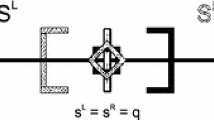Abstract
We develop a new framework for location of competitive facilities by introducing non-constant expenditure functions into spatial interaction location models. This framework allows us to capture two key effects – market expansion and cannibalization – within the same model.
We develop algorithmic approaches for finding optimal or near-optimal solutions for several models that arise from choosing a specific form of the expenditure functions.
Similar content being viewed by others
References
R. Aboolian, O. Berman and D. Krass, Spatial interaction location models with exponential expenditure functions, Working paper, Rotman School of Management, University of Toronto (2001).
D. Achabal, W.L. Gorr and V. Mahajan, MULTILOC: A multiple store location decision model, Journal of Retailing 58 (1982) 5-25.
O. Berman and D. Krass, Flow intercepting spatial interaction model: A new approach to optimal location of competitive facilities, Location Science 6 (1998) 41-65.
O. Berman and D. Krass, The generalized maximal covering location problem, Computers and Occupation Resource 29 (2002) 563-591.
R.C. Blattberg, R. Briesch and E.J. Fox, How promotions work, Marketing Science 14(3) (1995) 122-132.
M.L. Brandeau, S.S. Chiu, S. Kumar and T.A. Grossman, Location with market externalities, in: Facility Location, ed. Z. Drezner (Springer, Berlin, 1995) pp. 121-150.
M.L. Cornuejols, G.L. Nemhauser and L.A. Wolsey, The uncapacitated facility location problem, in: Discrete Location Theory, eds. R.L. Francis and P. Mirchandani (Wiley Interscience, New York, 1990).
R.L. Davies and D.S. Rogers, Store Location and Store Assessment Research (New York, 1984).
T. Drezner, Competitive facility location in the plane, in: Facility Location, ed. Z. Drezner (Springer, Berlin, 1995) pp. 291-298.
H.A. Eiselt and G. Laporte, Demand allocation functions, Location Science 6 (1998) 175-187.
A. Ghosh and C.S. Craig, FRANSYS: A franchise location model, Journal of Retailing 67 (1991) 465-487.
A. Ghosh and S.L. McLafferty, Location Strategies for Retail and Service Firms (Lexington Books, 1987).
A. Ghosh, S.L. McLafferty and C.S. Craig, Multifacility retail networks, in: Facility Location, ed. Z. Drezner (Springer, Berlin, 1995) pp. 301-330.
S.L. Hakimi, Locations with spatial interactions: competitive locations and games, in: Discrete Location Theory, eds. P.B. Mirchandani and R.L. Francis (Wiley Interscience, New York, 1990).
P. Hansen, J.-F. Thisse and R. Wendell, Equilibrium analysis for voting and competitive location problems, in: Discrete Location Theory, eds. P.B. Mirchandani and R.L. Francis (Wiley Interscience, New York, 1990) pp. 479-502.
D.L. Huff, Determining of intra-urban trade areas, Real Estate Research Program, UCLA (1962).
D.L. Huff, Defining and estimating a trade area, Journal of Marketing 28 (1964) 34-38.
K. Jones and J. Simmons, Location, Location, Location: Analyzing the Retail Environment, 2nd ed. (Neilson, Canada, 1993).
A.C. Lea and G.L. Menger, An overview of formal methods for retail site evaluation and sales forecasting: part 2, spatial interaction models, The Operational Geographer 8 (1990) 17-23.
H.L. Lee and M.A. Cohen, Equilibrium analysis of disaggregate facility choice subject to congestionelastic demand, Operations Research 33(2) (1985) 293-311.
M. Nakanishi and L.G. Cooper, Parameter estimates for multiplicative competitive interaction modelsleast square approach, Journal of Marketing Research 11 (1974) 201-311.
V. Nijs, M. Dekimpe, J.-B. Steenkamp and D.M. Hanssens, The category effects of price promotions, Marketing Science 20(1) (2001) 1-23.
A.G. Wilson, Entropy in Urban and Regional Modeling (Pion, London, 1970).
Author information
Authors and Affiliations
Rights and permissions
About this article
Cite this article
Berman, O., Krass, D. Locating Multiple Competitive Facilities: Spatial Interaction Models with Variable Expenditures. Annals of Operations Research 111, 197–225 (2002). https://doi.org/10.1023/A:1020957904442
Issue Date:
DOI: https://doi.org/10.1023/A:1020957904442




